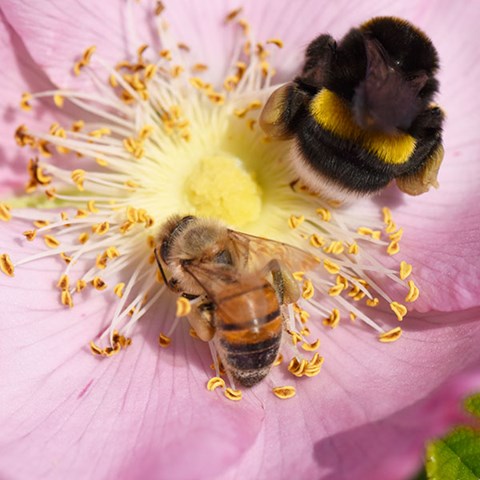Contact
Department of Ecology, NJ, Agricultural Entomology Unit

We study the evolution, adaptation and ecology of bee viruses, as well as their effects on their hosts. The core aim of our virus research is to elucidate how bee viruses interact with their hosts and the environment to modulate the distribution of viruses among bee species and their effects on bee health.
Viruses are a universal feature of life. Bees are no exception and, like all other organisms on earth, are host to a wide diversity of viruses. Most of these are non-pathogenic, but all have the potential to become pathogenic and cause disease, if the circumstances allow them to do so. How this happens depends on many factors, primarily how efficiently the virus is transmitted between individuals, but also on other stress-inducing or stress-reducing factors in the internal and external environment.
Viruses have small genomes and very short generation times, making them great tools for experimenting with evolution and adaptation in real time. Viruses are genetically very dynamic, existing as a cloud of variants whose composition changes constantly through a combination of highly error-prone replication and strong selection for the best adapted variants, which then temporarily dominate this cloud, or ‘quasi-species’. One of our interests is to map this variability and selection on the viral genomes, and determine its relation and relevance to key events in infection, pathology or host adaptation. Other projects in this section include basic characterization and classification of bee viruses in general, through both virus prospecting and through targeted analysis of historical isolates of pathogenic viruses.
The effect that viruses have on their hosts are often related to how they are transmitted. Since coordinating the work in social bee colonies involves a lot of direct contact and communication, many bee viruses affect the behaviour of individual bees. This can have both positive and negative consequences for the colony, particularly in relation to the removal of diseased brood and bees from the colony. We have several projects addressing these complex concepts, essentially concerning the different types of roles of viruses in a bee colony. Also included in this topic are several projects on the response of the host to virus infections, through transcriptomic, metagenomic and/or genomic adaptations.
Most bee viruses are part of a community of pathogens that are shared between many different bee and pollinator species, frequently through shared floral networks. Viruses therefore also can have an ecological function for bees, in defining niches and mediating competitive advantages over other bee species. Some viruses are known to markedly affect foraging preferences, distance and efficiency, and different viruses affect different bee species to greater or lesser degree. Bee pathogens can thus affect pollination, floral landscape composition and perhaps even competition between plants for pollination services and the evolution of floral traits. Also included in this topic are landscape-level effects on bees, through foraging and exposure to environmental factors, and what role viruses have in this. We have a few projects in this topic, and hopefully more to come.